Japan
Wood Products Prices
Dollar Exchange Rates of 25th
August
2020
Japan Yen 106.59
Reports From Japan
Is this the end of Abenomics?
The Japanese Prime Minister, Shinzo Abe, has resigned
and this comes just days after achieving the record as the
longest serving Japanese Prime Minister. His departure
may signal the end of the ¡®abenomics¡¯ experiment which
was designed to reverse the persistent deflation in Japan
through massive monetary easing and a 2% annual
inflation target adopted by the Bank of Japan.
Critics of ¡®abenomics¡¯ had, until Abe¡¯s resignation, been
circumspect but now there has been more open criticism of
the policy which, even, before the corona virus pandemic,
was not delivering on raising consumer spending or
company capital investment.
Even before the pandemic ¡®abenomics¡¯ failed to deliver
the domestic conditions that would drive higher growth
beyond reliance on international demand and now, as the
economy has been decimated by pandemic control
measures, Japan is paying a big price as any short-term
benefits brought by ¡®abenomics¡¯ have been wiped out.
Perhaps the greatest disappointment with ¡®abenomics¡¯ was
the elusive reforms to reshape the economy which suffers
low productivity, rigid labour market and a rapidly ageing
population.
The aim of ¡®abenomics¡¯ to encourage companies to
increase capital expenditure did not succeed but access to
cheap money allowed companies to build up cash reserves.
This policy, which is now paying off as companies have a
huge cash resource, is serving as a liquidity buffer to
survive the shock from the pandemic. The pandemic has
reassured corporations that cash is indeed king.
The priority at the moment is recovery of the economy
which will now fall on the next Prime Minister who will
be chosen by the ruling Liberal Democratic Party.
See:
https://www.nasdaq.com/articles/analysis-abenomics-failsto-deliver-as-japan-braces-for-abe-resignation-2020-08-28
Recovery not until 2022
The Japanese economy recorded its biggest decline in the
second quarter of this year and many commentators warn
that the country must be prepared for a long drawn out
recovery and a weak job market.
The Cabinet Office has suggested annual growth could fall
a further 5% for the year to March 2021.
Although recent data indicates the slowdown in
consumption and production may have slowed, it could be
until 2022 that the economy could return to levels before
the pandemic. June unemployment figures were low
compared to many other countries but analysts warn
underemployment is emerging as a problem.
Saito Taro, executive research fellow at NLI Research
Institute, predicts that the jobless rate will climb to four
percent by the end of this year.
See:
https://www.nliresearch.co.jp/en/report/detail/id=65192?site=nli
and
https://www3.nhk.or.jp/nhkworld/en/news/backstories/1258/
Machinery orders
The total value of machinery orders received by
manufacturers operating in Japan declined by 8.4% in June
from the previous month and in the second quarter fell by
17.7% compared with the previous quarter. Weak private
consumption and international demand took its toll on
machinery orders. Orders from overseas, an indicator of
future exports, declined 4% in the second quarter
following the fall in the first quarter.
Machinery orders are a key advance indicator for
corporate capital spending and the government uses this
key data to predict the strength of business spending in six
to nine months.
See:
https://www.esri.cao.go.jp/en/stat/juchu/2020/2006juchue.html
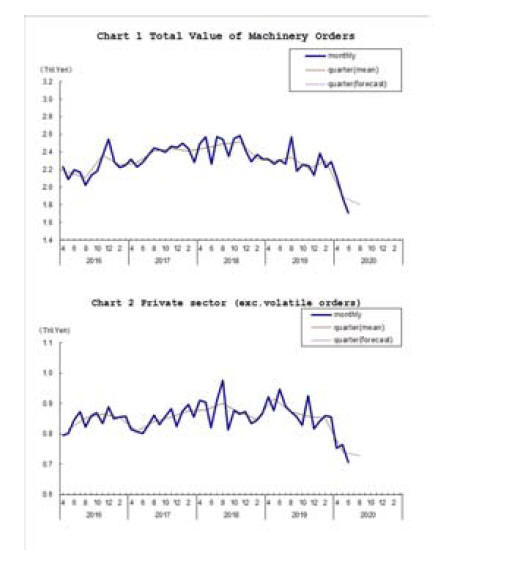
Consumer confidence stalls as corono-virus
second
wave expands
The latest Cabinet Office survey shows Japan's consumer
confidence index fell slightly in August dropping for the
first time in three months as the coronavirus crisis
continues to cloud the outlook for jobs and the economy.
See:
https://www.todayonline.com/world/japans-consumerconfidence-index-slips-august

Bank of Japan holds the key to exchange
rates
The combined effect of a weakening dollar and the
resignation of the Japanese Prime Minister lifted the yen
against the US dollar but the change was short lived. What
is more likely to impact the longer term yen/dollar
exchange rate will how the policy of the Bank of Japan
may change.
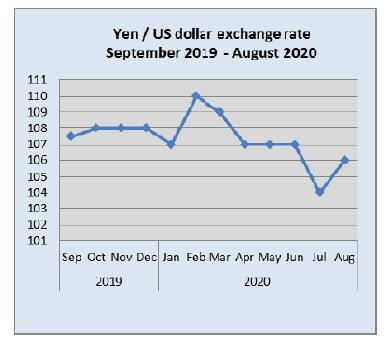
July housing starts down 11% year on year
The month end release of housing statistics shows that
July housing starts were little changed from the level seen
in June but, year on year, July starts were around 11%
down.
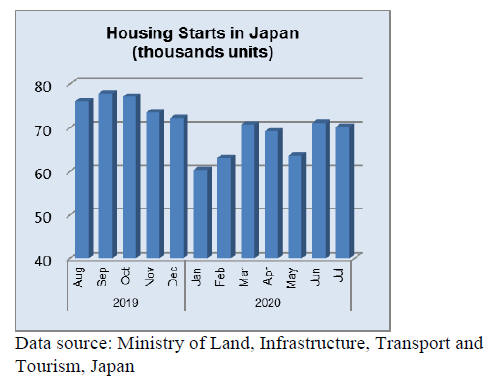
Import update
Wooden door imports
In the first half of 2020 the value of Japan¡¯s imports of
wooden doors (HS441820) were down 26% from the same
period in 2019.
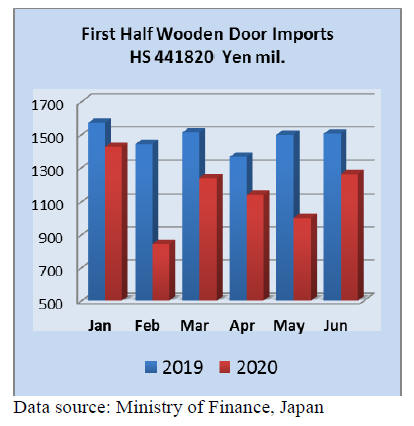
After several months of declines the value of door
imports
in June moved higher compared to levels in May. Month
on month there was a 26% rise in the value of June
imports but year on year the value of imports dropped
16%.
In June the main shippers of wooden doors to Japan were
China (68% of June imports), the Philippines (13%),
followed by Indonesia and Malaysia with around 5% each.
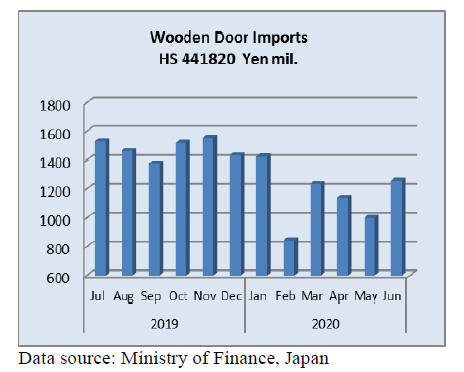
Wooden window imports
In the first half of 2020 the value of Japan¡¯s imports of
wooden windows (HS441810) was down 26% from the
same period in 2019.
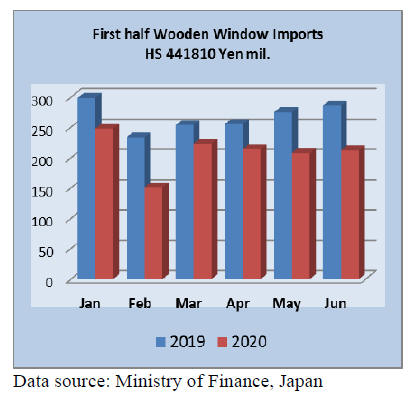
The pattern of imports of wooden windows (HS441810)
mirrors that of door imports. The value of June 2020
imports of wooden windows was down 26% year on year
but was about level with the value of May imports and as
such arrested the slight decline in monthly import values
that was first seen in April.
Shipments from three supply countries made up 80% of all
June imports of wooden windows with exporters in China
accounting for over half of the total followed by the US
(15%) and the Philippines (12%). Much of the 20%
balance was sourced from shippers in Europe.
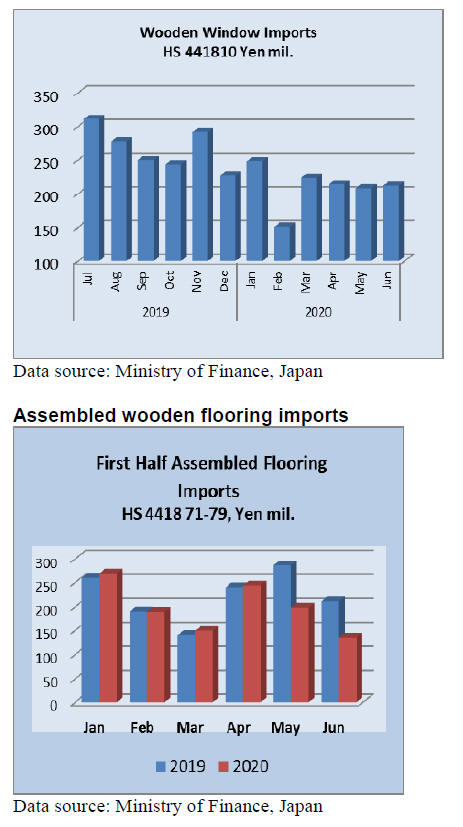
The two consecutive monthly declines (May and June)
in the
value of assembled flooring imports underlines the depressed
state of the housing market in Japan.
Year on year the value of assembled flooring imports dropped
36% in June 2020 and month on month there was a 32% decline
adding to the drop in imports seen in May.
Of the various categories of flooring imported HS 441875
accounted for over 70% of June imports as it has done in past
months and was supplied mainly by shippers in China and
Vietnam. A further 17% of imports was of HS441879 supplied
by shippers in mainly Thailand and Vietnam.

Plywood imports
There has been a steady decline in the volume of Japan¡¯s
plywood imports in the first half of 2020. Year on year the
volume of plywood imports dropped 28% in the first half
of 2020.

Indonesia and Malaysia are the top shippers of
plywood to
Japan accounting for over 80% of all plywood imports.
In June arrivals from Malaysia were down 26% compared
to May and year on year June imports were around 13%
down. In contrast, the volume of June imports from
Indonesia was around the same level as in May and were
marginally lower than in June 2019.
Plywood imports from China are small at about 10,000
cu.m monthly but was noticeable in the first half import
data is that shipments of plywood from Vietnam were for
the first time greater than from China.
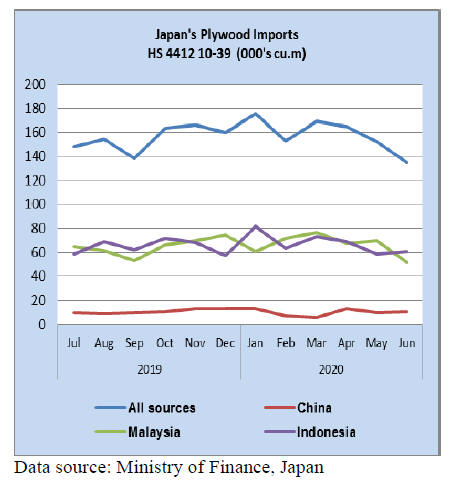
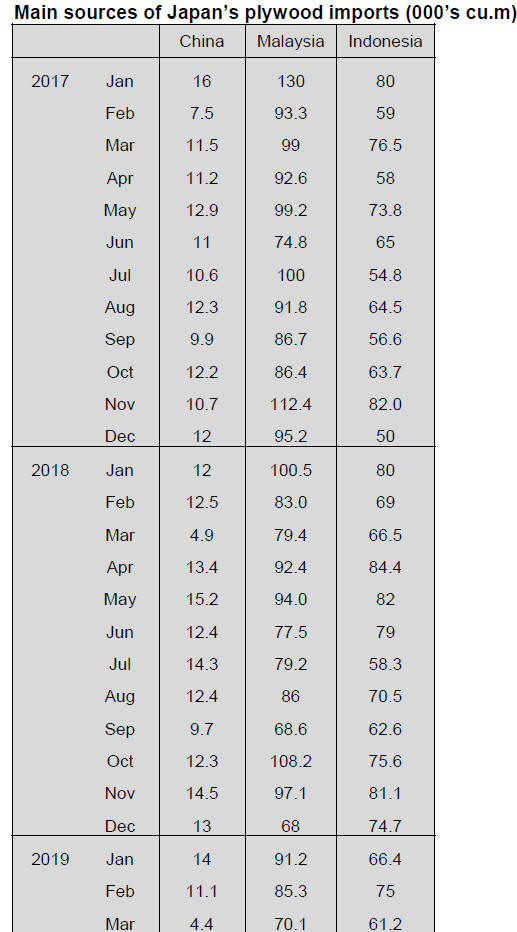 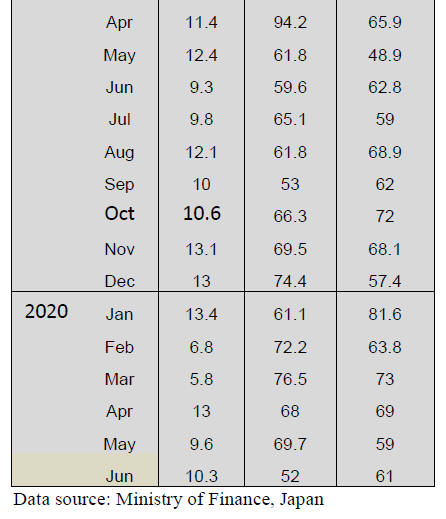
Trade news from the Japan Lumber Reports
(JLR)
The Japan Lumber Reports (JLR), a subscription trade
journal published every two weeks in English, is
generously allowing the ITTO Tropical Timber Market
Report to reproduce news on the Japanese market
precisely as it appears in the JLR.
For the JLR report please see:
https://jfpj.jp/japan_lumber_reports/
Prospect of market after August
Market of building materials continues weak. New
housing starts until in June are 398,120 units, 11.4% less
than 2019. This is not so bad considering corona virus
epidemic started in early this year but many fears more
drop in coming months so dealers hesitate to procure
building materials.
Structural materials market such as beam lumber got into
price war. Softwood plywood manufacturers started
production curtailment by 20% before the market
deteriorated but count not stop price skid. Market prices
of structural softwood panel are now about 900 yen per
sheet delivered, the lowest in four years.
According to the survey made by the Japan Forest
Products Journal, orders through July are more than 90%
(for processing capacity), which is about 10% less than
2019 but considering negative factors, it is rather high
level.
This coordinates to decrease of new housing starts by
about 10% so the first half of this year was not so bad.
Major house builders¡¯ orders in last April and May drop
sizably by 30-40% because of house quarantine for
corona virus epidemic so this will lead drop of housing
starts in summer months but such builders¡¯ orders in June
recovered to only 15% less than June last year so there
are optimistic comments now.
Major builders report that number of people visiting
house exhibition sites are back to normal and large sales
campaign events also started. Order made house builders
suffered after face to face negotiations became prohibitive
by corona virus epidemic while builders, which have
ample information on web site are successful in getting
enough customers.
However, the generation visiting exhibition sites are
young while aged people hesitated to go out in fear of
catching the virus. Wealthy aged generation, which is
likely to have property to put up house, is the target of
order made house builders but they quarantine at home.
Younger people may not be immediate buyers but they
are potential buyers so the builders think it is seeding time
now. In the U.S.A., major cities were lock-down to
prevent spread of corona virus so new housing starts of
1.56 million units nosedived to 930,000 in April then
after economic activities started in May, housing starts
made V shape recovery of 1.01 million in May and 1.18
million in June.
In Japan, there were no lock-down so number of new
housing starts did not drop so much compared to the
U.S.A. and as the orders are recovering after the State of
Emergency was lifted in late May, there might not be so
sharp drop.
As to building materials, dealers in Japan anticipate
further drop of the demand so procurement activities are
down so if there is no sharp drop of housing starts in
coming months, supply of the materials may get tight like
the U.S.A. where lumber market steeply climbed with
increase of housing starts because many mills curtailed
the production and the supply was tight so structural
lumber¡¯s average prices reached the record high.
It is unlikely that the same would happen in Japan but
weak materials market may bottom out and rebound on
tight supply items. Some items are over-supplied like the
European laminated lumber and the Russian lumber while
North American logs and lumber are firm and the
European lumber market is recovering.
Radiata pine logs and lumber supply this year is way
down. Log import through June was 21.0% less than 2019
and Chilean lumber import was 35.9% less. The demand
for crating is much slower than construction materials.
Japanese domestic radiate pine lumber mills¡¯ production in
April was 10-20% less than 2019 and May through July
was 30-40% less.
There are mixed views for future market and many thinks
that things are not as bad as initially feared. Others think
that there will be steep cliff ahead but nobody knows when
and how deep.
South Sea (tropical) logs
Supply of South Sea logs for the first six months of this
year is 56,700 cbms, 25.6% less than 2019. Users carry
two to three months inventory. The shipment of products
is slow. Users like plywood manufacturers are reducing
purchase of logs since orders from the customers are
declining.
Low arrival seems to continue. Suppliers¡¯ export prices of
Indonesian mercusii pine free board dropped so the
market prices in Japan declined. In every year, August is
busy season for interior repair works of schools during
summer vacation but this year is different as school
summer vacation is shortened to catch up closed period in
spring when corona virus started spreading so such works
are postponed. Demand of free board is slow as orders of
repair of shops and stores are down.
Plywood
Plywood movement continues stagnant. Down trend of
market prices seems to be bottoming as softwood plywood
manufacturers determined to stop further skidding of
market prices and imported plywood inventory is getting
low and the dealers have started cautious marketing.
Market prices of domestic softwood plywood sharply
dropped in June and early July then the manufacturers
notified dealers that they would not accept any lower
offers. The dealers are following the move of the
manufacturer since lowering sales prices does not help
move any more volume.
August is vacation month with many holidays so the
manufacturers decided to reduce the production more than
30% in hope of the prices bottoming out but future outlook
of the market is very ambiguous and the market continues
having uneasiness. Movement of imported plywood is
improving since last July.
The dealers¡¯ activities have been passive with fear of
demand retreat and price deterioration but there are many
supply short items and it is reported that shipments from
warehouses in Tokyo Bay exceeded incoming volume for
two straight months of June and July so the port inventory
is further dropping. June supply of imported plywood was
180,460 cbms, first time to dip below 200,000 cbms in
four months.
With uncertain future market, the importers made very
little purchase since April but September is interim book
closing month so that the importers try not to increase
order balance. Therefore, the arrivals seem to continue low
for coming months.
Clean-up of Aomori¡¯s dead stock logs
Local cedar logs produced in Aomori prefecture increased
as dead stock after the demand dropped by corona virus
epidemic.
There were about 60,000 cbms of logs at log yards in June
and quality deterioration was feared in warm weather.
The prefecture and the Forest Association of Aomori tried
hard to dispose of produced logs and succeeded to move
about 37,000 cbms to local LVL and lumber mills.
The prefecture decided to subsidize two third of
transportation cost of stocked logs so the Forest
Association succeeded to export 15,000 cbms of logs to
China. By these efforts, fear of quality deterioration and
resultant drop of market prices is avoided.
For log export, there are three shipments from three
different ports in Aomori prefecture. Aomori has long
experience of log export to China together with
neighboring Akita prefecture and it plans to keep looking
for more buyers in China.
|